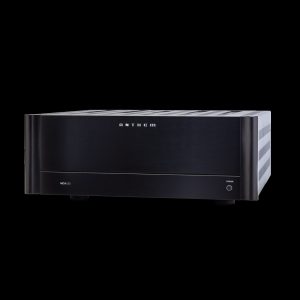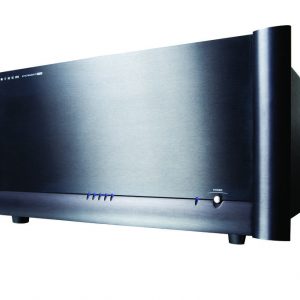Description
Cutting Edge Technology & Design
Full resolution of all of the sonic subtleties and complexities in the input signal.
Accurate reproduction of the full dynamic range of the signal.
Output stage is never allowed to clip.
No compression as output increases.
Flat frequency response into any load, without having to resort to digital conversion or equalization to compensate.
Stable into all loads including open circuit and short circuit.
A low noise floor.
Exceptional efficiency with low heat output.
An amp so mechanically silent it will suit even the quietest listening room.
A design that allows multiple units to be stacked with no danger of overheating.
All of the above delivered at a price point that while not inexpensive, delivers virtually limitless dynamic fidelity.
FACT!
At 4 ohms (which is where high-end speakers hang around) our award-winning Statement P5 amplifier outputs 500W. With 2 kW the M1 outperforms it by 6dB. That’s quite an advantage.
Best Value in the Market
The M1 enjoys all of the attributes of our award-winning Statement Class AB amplifiers but through exclusive Anthem technologies, goes far beyond the current capabilities of Class A, Class AB and prior Class D amplifiers in the market.
The proprietary design employs all of the advantages of a Class D amplifier — high output, high efficiency, compact size — while avoiding the typical Class D limitations such as difficulty driving low-impedance (high-end) speakers, power line contamination, reliability issues and substandard audio quality. The absence of accurate dynamics is so common that it frequently goes unnoticed, but through the M1, music and movies are delivered with breathtaking realism.
POWER!
2,400W into 3 ohms
2,000W into 4 ohms
1,000W into 8 ohms
* These figures are continuous from 20 Hz to 20 kHz at less than 0.1% THD+N. The M1 can deliver 2 kW continuously when fed by 240V mains and 2 kW for several seconds when fed by a dedicated 120V 15A line.
Addressing the Class D bias
The “D” in Class D does not stand for digital. It was simply the fourth type of amp recognized and classified by the IEEE. The first was Class A, the second Class B, the third Class C, etc.
Contrary to the bias that exists among high-end enthusiasts and across the industry in general, the Class D design is not inherently flawed. The truth is that no existing designs have been able to reach the Class D’s inherent potential for performance. It is not the technology that yields fine audio performance but rather the implementation of the technology. At Anthem, we agree that most Class D amplifiers are poor performers. However the M1 uses Class D amplification of a different ilk (see later section on Class D for a full discussion).
The M1 is not a digital amp!
There are no A/D or D/A converters in the signal path. The amplifier’s control system continuously varies the width of the output pulse train in direct relation to the analog input signal. In essence, a side-to-side variation in width is analogous to a signal’s more familiar up-and-down amplitude variation, not at all the same as a digital string of 1s and 0s where all pulses have the same width.
Exceptional efficiency
Much has been written about Class D amps having twice the efficiency of conventional amplifiers at full output, but there’s more to this. Under normal conditions an amplifier operates at only a fraction of its full output capability. At 1/8th of its maximum output (the typical working level of an amplifier), our M1 is six times more efficient than a conventional amplifier.
Slim Size, Beefy Power!
Never judge an amp by its size or its rack space
Amplifiers are often judged by their size and weight, the beefier the better since more power requires a physically heavier, larger amplifier. Or does it? It all depends on the design. When rack-mounted, the 20-kb M1 occupies only one rack space but despite its size can deliver 1,000W into 8 ohms and 2,000W into 4 ohms.
Cool running
The M1’s cooling system quickly and efficiently moves heat from the interior of the amplifier to exterior heat sinks. Sealed copper pipes within the amp contain a small amount of special fluid held under a vacuum. When the temperature at one end of the pipe rises — the end adjacent to the amplifier’s heat sources — the fluid in that end evaporates. This vapor is then naturally drawn to the cooler end of the pipe, along the heat sink on the side of the amp’s chassis where it condenses. From there a copper wick returns the fluid to the hotter end of the pipe. This heat transfer process is many thousands of times faster and more efficient than cooling through metal heat sinks alone. This system eliminates the need for fans, allowing multiple M1s to be stacked with no danger of overheating. It also means the amplifier is so mechanically quiet it will suit even the quietest listening rooms.
No noise is good news
With an absence of noisy fans and a noise floor well below that of a high-end preamplifier, the M1 is a critical listener’s dream.
Advanced Load Monitoring & Power Factor Correction
Proprietary Load Monitoring
The M1 has a very sophisticated load monitoring system. Two 100A Hall-Effect sensors monitor the output current. A Digital Signal Processor, outside the signal path, is used for power sequencing and to monitor various amplifier and power supply functions including line voltage, output current, ground fault detection, temperature and DC voltage at the output.
The M1’s output stage does not interact with the load. A hysteric PID controller which uses past, present and a predicted future to make adjustments keeps the amp load independent. Hundreds of computer simulations were used to test and optimize this system so that it is able to handle all possible loads. This is a significant design achievement. Whether you are running the M1 from a 120V circuit or a 240V circuit, the amplifier will be delivering the highest output possible according to the operating conditions.
Power Factor Correction
Power Factor Correction (PFC) maximizes available power and at the same time reduces (by a large amount!) the noise put on the AC line. Without PFC, the input current can flow and charge the capacitors only during the short moments that voltage is at or very close to its positive or negative peak. Since power is the product of both voltage and current it is produced only when both are present. Power Factor Correction marries the voltage and current cycles enabling continuous output from the power supply through the entire AC cycle. In doing so, the load appears almost purely resistive to the AC source. (See diagrams to right)
The special advantages of bridged mode amplification in the M1
Lower voltage MOSFETs can be used for lower resistance and higher speed. Although more expensive since more MOSFETs are needed, sound quality is vastly improved.
Because the load is balanced, output current goes from one rail to the other without disturbing the ground plane. A balanced load also provides more efficient use of the power supply. Rail voltage is stable, unlike in single-ended Class D amps which suffer from rail pumping at low frequency and high power.
Power supply capacitors become more efficient because bridging doubles the ripple frequency while impedance and ripple voltage are halved, allowing the power supply capacitors to be more efficient.
For a high-power amp such as the M1, bridging can be safer. The differential output voltage can reach over 90 Vrms but at this level each output terminal is only 45 Vrms with respect to the chassis.
Additional high-end touches
Hand-designed 4-layer FR4-rated glass-epoxy circuit board with 2-ounce copper traces promotes exceptional conductivity.
Extensive use of power and ground planes ensures vanishingly low levels of noise and inductance to produce an amp that gets out of the way, leaving only the sound of the music.
Each of the eight 65-amp MOSFETs can handle a peak current of 260 amperes, has low gate charge for fast response, low channel resistance for high efficiency and high speed for high efficiency and low distortion.
No relays are used in the signal path preventing any possibility of relay failure.
Why doesn’t the M1’s power cord have a third prong?
Although more difficult and expensive to implement, Anthem has always used 2-prong AC cords to make installation easier.
A 3-prong cord is prone to ground loops if the system includes other 3-prong equipment or cable/satellite TV. For example: If the preamplifier uses three prongs it is grounded not only through its power cord but also through any non-optical connections to other 3-prong components. This can result in humming or buzzing through the speakers as well as video noise problems. The more elaborate the system, the greater the chance of a ground loop. With 3-prong equipment, balanced XLR interconnection is needed throughout and that type of interconnection is not always possible.
With a 2-prong cord, safety is maintained through either double or reinforced insulation. The next time you see a corded power tool, look for the double-square symbol. It requires more expensive wires on the live side and greater distance between live circuits and isolated circuits and chassis. The distance requirement also applies to spacing inside transformers, making them larger and more expensive. A 2-prong cord also requires a larger line filter because according to safety standards the line-chassis leakage current limit is ten times lower compared to 3-prong. Ironically, a higher leakage current allowance aggravates hum problems in 3-prong systems.
To clear up any final misconceptions, the earth ground provided by the third prong is not meant as a shield, it is a safety measure meant to trip breakers should a chassis become live as a result of coming into contact with a live wire.
FACT!
The “D” in Class D does not stand for digital. It was simply the fourth type of amp recognized and classified by the IEEE. The first was Class A, the second Class B, the third Class C, etc.
Not all Class D amplifiers are created equal!
In the audio press and across the Internet many generalizations have been made about deficiencies in Class D amplifier design. While such generalizations may hold true for other brands of amplifiers, below, Anthem responds to each one as it relates to our M1.








